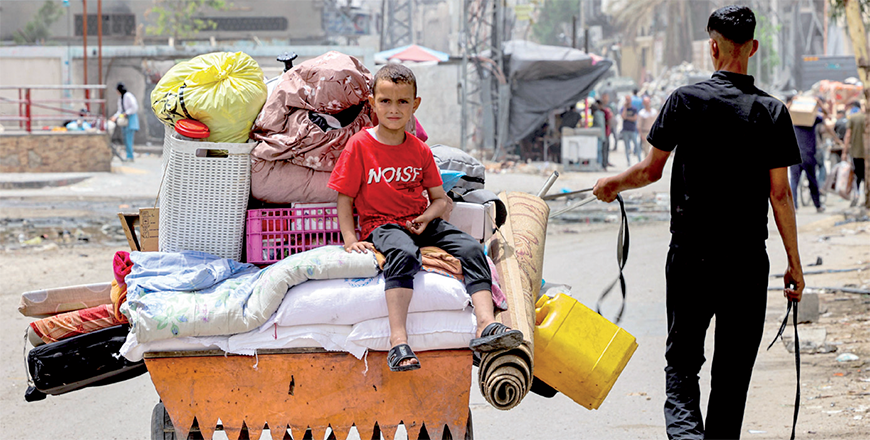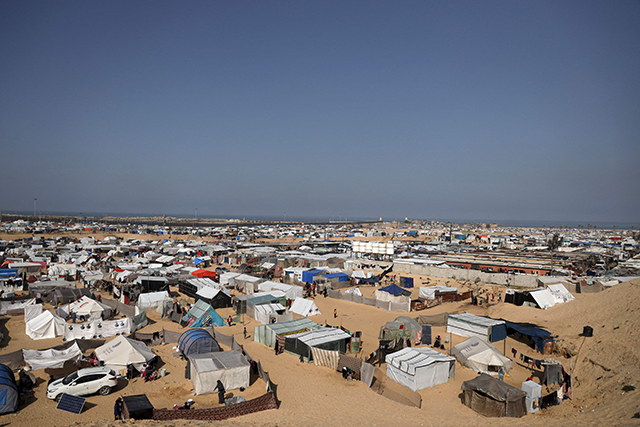You are here
Fighting rages across Gaza as death toll tops 35,000
By AFP - May 13,2024 - Last updated at May 13,2024

A boy looks on as he sits atop cushions and mattresses loaded in the back of an animal-drawn cart led by a man as they evacuate from Sheikh Zayed in the northern Gaza Strip on May 11, 2024 (AFP photo)
RAFAH, Palestinian Territories — Israel struck Gaza on Sunday and troops were battling militants in several areas of the Hamas-run territory, where the health ministry said the death toll in the war had exceeded 35,000 people.
More than seven months into the Hamas-Israel war, UN chief Antonio Guterres urged "an immediate humanitarian ceasefire, the unconditional release of all hostages and an immediate surge in humanitarian aid" into the besieged Gaza Strip.
"But a ceasefire will only be the start," Guterres told a donor conference in Kuwait. "It will be a long road back from the devastation and trauma of this war."
As Egyptian, Qatari and US mediation efforts towards a truce appeared to stall, US President Joe Biden said on Saturday a ceasefire could be achieved "tomorrow" if Hamas released the hostages held in Gaza since the October 7 surprise attack that sparked the conflict.
AFP correspondents, witnesses and medics said Israeli air strikes pounded parts of northern, central and southern Gaza during the night and into Sunday morning.
The Israeli military said its jets had hit “over 150 terror targets throughout the Gaza Strip” over the past day.
In Rafah, Gaza’s southernmost city which sits on the border with Egypt, the Kuwaiti hospital said Sunday it had received the bodies of “18 martyrs” killed in Israeli strikes over the past 24 hours.
The health ministry in the territory said that at least 63 people had been killed over the last 24 hours, bringing the overall death toll from Israel’s bombardment and offensive in Gaza to at least 35,034 people, mostly women and children.
Fighting in northern Gaza
Months after Israel said it had dismantled Hamas’s command structure in northern Gaza, fighting has resumed in recent days in Jabalia refugee camp and Gaza City’s Zeitun neighbourhood.
Military spokesman Rear Admiral Daniel Hagari said late on Saturday that “in recent weeks we have identified attempts by Hamas to rebuild its military capabilities in Jabalia, and we are acting to destroy these attempts”. He also said there was an operation in Zeitun.
The military said on Sunday its troops were operating in Jabalia after launching an operation overnight.
AFP correspondents reported intense clashes and heavy gunfire from Israeli helicopters in the Zeitun area early Sunday, with medics and witnesses saying troops were fighting in Zeitun as well as Jabalia.
Israel defied international opposition this week and sent tanks and troops into eastern Rafah, effectively shutting a key aid crossing.
On Saturday, the Israeli military expanded an evacuation order for eastern Rafah and said 300,000 Palestinians had left the area.
The UN agency for Palestinian refugees, UNRWA, gave a similar estimate of “around 300,000 people” who have fled Rafah over the past week, decrying in a post on X the “forced and inhumane displacement of Palestinians” who have “nowhere safe to go” in Gaza.
And the UN’s human rights chief Volker Turk on Sunday warned that the evacuation orders, “much less a full assault”, could not be “reconciled with the binding requirements of international law” or two recent rulings by the International Court of Justice on Israel’s conduct of the war.
‘No safe place’
Palestinians in Rafah, many of them displaced by the fighting elsewhere in the territory, piled water tanks, mattresses and other belongings onto vehicles and prepared to flee again.
“The artillery shelling didn’t stop at all” for several days, said Mohammed Hamad, 24, who has left eastern Rafah for the city’s west.
“We will not move until we feel that the danger is advancing to the west,” he told AFP.
“There is no safe place in Gaza where we can take refuge.”
Residents were told to go to the “humanitarian zone” of Al Mawasi on the coast northwest of Rafah, though aid groups have warned it was not ready for an influx of people.
EU chief Charles Michel said on social media that Rafah civilians were being ordered to “unsafe zones”, denouncing it as “unacceptable”.
Hisham Adwan, spokesman for the Gaza crossings authority, told AFP on Sunday that the Rafah crossing has remained closed since Israeli troops seized its Palestinian side on Tuesday, “preventing the entry of humanitarian aid” and the departure of patients needing medical care.
He said Israeli forces “have advanced from the eastern border” about 2.5 kilometres into Rafah.
At the Kerem Abu Salem crossing, site of multiple clashes, the army said it had intercepted two launches fired at the crossing from Rafah.
Protests
Israel began what it termed a “limited” operation in Rafah this week, while the international community has repeatedly condemned the possibility, long-threatened by the Israeli government, of a full-scale ground invasion of the city.
Israel’s close ally the United States paused the delivery of 3,500 bombs as it appeared ready to invade Rafah.
Protests against the war spread to Saturday’s Eurovision Song Contest in Sweden, where thousands rallied outside the Malmo Arena condemning Israel’s participation.
Meanwhile, in Tel Aviv on Saturday, Israeli protesters again took to the streets to pressure their government to do more to reach a truce and hostage release deal.
The rally came hours after Hamas’s armed wing said a hostage, Israeli-British man Nadav Popplewell, had died in captivity. The Israeli military did not offer any comment on the Hamas video statement.
Related Articles
GAZA CITY, Palestinian Territories — Israel continued with its attack on Gaza on Monday, including in far-southern Rafah, despite US warning
RAFAH, Palestinian Territories — Heavy clashes and bombardment rocked the southern Gaza city of Rafah on Saturday, as the United Nations sai
Gaza Strip, Palestinian Territories — The Gaza war's reported Palestinian death toll neared 30,000 Wednesday as fighting raged in the Hamas-


















